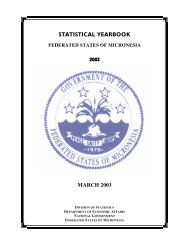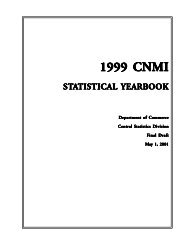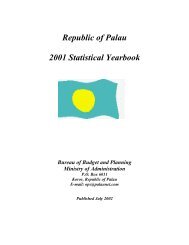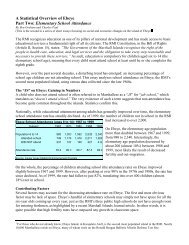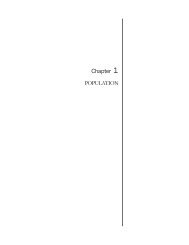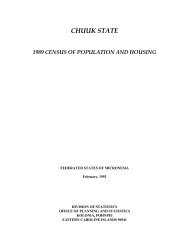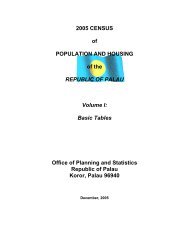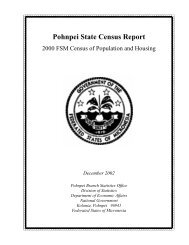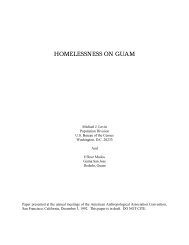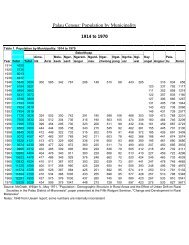Chapter 1. Introduction2000 FSM <strong>Census</strong> of <strong>Chuuk</strong> <strong>State</strong>Typhoon Owen passed through the Northern Outer Islands (The Halls and Nomunuito) devastating many of the smallatoll islands.Regional Sub-Division<strong>Chuuk</strong> <strong>State</strong> is divided into five (5) political regions. <strong>Chuuk</strong> Lagoon has 3 of the regions: (1) Northern Namoneas (7.75square miles), consisting of Weno (formerly known as Moen), Piis-Paneu (formerly Piis-Moen), and Fono;(2) SouthernNamoneas (11.72 square miles), consisting of Tonoas (formerly Dublon), Fefen ,Etten, Siis, Uman, Parem and Totiw;and (3) Faichuk (19.25 square miles), consisting of Eot, Udot, Romonum, Fanapanges, Wonei, Paata, Tol and Polle.<strong>Chuuk</strong> Outer islands makes up the two remaining regions:(4) The Mortlocks (4.91 square miles) consisting of Nama,Losap, Piis-Emwar, Namoluk, Ettal, Lekinioch, Oneop, Kuttu, Moch, Satowan and Ta; and (5) Oksoritod (10.6 squaremiles) is formally divided into three areas which are: (1) The Halls (Nomwin, Fananu, Ruo, and Murilo), (2)Namonuito (Makur, Onou, Unanu, Onoun and Piherarh), and (3) Pattiw (Houk, Polowat, Pollap, and Tamatam). Justoutside <strong>Chuuk</strong> Lagoon is small Kuop Atoll, belonging to the people of Uman. The island area of these lagoon islands is38.6 square miles and makes up almost 80 percent of the state's land area. All of <strong>Chuuk</strong>'s Outer Islands are composedof coral and most are atolls. The Outer Islands have a total land area of just 10.6 square miles with approximately 1,200square miles of lagoon area.A Brief History of <strong>Census</strong> TakingBefore the coming of the Europeans, <strong>Chuuk</strong> and the islands around <strong>Chuuk</strong> were much more heavily populated 1 . Thepopulation of <strong>Chuuk</strong> was estimated at 35,000 in 1827 (Lutke, 1835). In 1874, a Rev. E.T. Doane traveled on the 'Star'from Pohnpei to the Mortlocks, and wrote back to the Geographical Magazine, published in London. The ship wentfirst to Satowan, where Doane counted "about 1500" people, with about 600 on one islet. He recorded "some 600 ormore" on Ettal. The population on Namoluk was "from 300 to 500". When the ship went on to Losap, Doane found:All the surroundings of the people, their language, dress, proas, ornaments, tattooing, dwellings, the children inundress, and the women with the native tapa, showed they were in kith and kin with the islanders alreadyvisited. The population may reach 500. The island seemed fertile, and capable of furnishing plenty of food(Doane 1874:204-5).Doane found no more than 150 to 200 persons on Nama, from reports of Natives on the ship. About 1,500 were onLekinioch. The ship went on to Nukuoro after this.Spanish AdministrationThe early Spanish voyages into Micronesia served to introduce islanders to the marvels of Western technology -- shipsas large as meetinghouses and strange-looking men with impermeable skin (armor). Of all these wonders the mostprecious was iron, the durable material that could be worked into tools and weapons. Islanders were quick toappreciate the advantages of iron as a replacement for their fragile implements of bone, shell, and stone. When theSpanish colonized the Mariana’s at the end of the 17th century, the <strong>Chuuk</strong>ese, employing the outer island navigators astheir middlemen, carried on trade with Guam for iron. If Europeans would not come to <strong>Chuuk</strong>, the islanders would sailhundreds of miles to search them out and barter for the metal that was more precious in their eyes than gold (Gorenflo& Levin, 1992).By the end of the 18th century, Europeans were again plying the Pacific, this time to reap a share of the profits in thelucrative China trade. As they did, they rediscovered the Pacific -- sighting and visiting islands that had never beforebeen seen by white men, correcting erroneous positions recorded 200 years earlier and redrawing the maps of theregion. In 1795, James Mortlock, captain of the British trading vessel Young William, gave his name -- and for a timethat of his ship -- to the group of atolls southeast of <strong>Chuuk</strong>. Nearly 30 years later, John Hall, while in command ofanother British vessel, sighted the islands that still bear his name. There were dozens of other sightings and brief visits:Monteverde at Nama in 1806; Lutrell at Namoluk, Nama, and Losap in 1808.In the wake of the early pioneers of the China trade came the naval explorers from France and Russia. When Freycinet,the commander of the earliest of them, stood off Houk for a few hours in 1819, he was greeted by a throng of islanderswho chanted "loulou" (the Chamorro loanword for iron). The next of the French naval commanders, Louis Duperrey,1 Part of this section from Hall and Pelzer, 1946.2 <strong>Chuuk</strong> Branch Statistics Office, Division of Statistics, FSM Department of Economic Affairs
2000 FSM <strong>Census</strong> of <strong>Chuuk</strong> <strong>State</strong>Chapter 1. Introductionwho visited the area in 1824 and mapped half of the <strong>Chuuk</strong> lagoon, reported the same experience at Pollap. "The wordloulou is always on their lips," he wrote. "Axes, knives, nails and large fishhooks are all objects of great value forthem." When the Russian naval party under Feodor Lutke spent a week in the Mortlocks in 1828, he found the peopleto be surprisingly demanding traders. They scoffed at the iron bars and hoop they were offered and insisted ontinderboxes and knives instead. The iron based traffic with Guam and the passing contact with European and Americanships had given the outer islanders cosmopolitanism that sometimes astonished ship captains. Tobacco had alreadymade its way into many of these islands and cock fighting was a popular pastime on Murilo by the early 1920s. Oneold man from the Namonuitos astonished a captain by carrying on a conversation in Spanish while devouring pate-defoie-graswith unfeigned relish.Throughout this period of contact, the high islands of <strong>Chuuk</strong> remained something of a backwater. Like the inhabitantsof other volcanic islands in Micronesia, the people there had lost their navigational skills through disuse over the years.They were also less visited than the atolls and were less accustomed to dealing with foreign merchants and seamen.Moreover, the high islands were plagued by the incessant war between districts that was carried on amid ever shiftingalliances. Dumont d'Urville, the last of the great French naval commanders to visit Micronesia, brought his two shipsinto the <strong>Chuuk</strong> lagoon in 1839 and anchored off Fefen. The Frenchmen found the islanders thoroughly unfamiliar withmuskets, European food (cheese and wine and biscuits), and even clothes. The French visit ended tragically when adozen <strong>Chuuk</strong>ese were killed in a battle that broke out between the visitors and the people of a nearby island. The nextvisitor to <strong>Chuuk</strong>, Andrew Cheyne in 1844, was also attacked. As Cheyne's schooner lay at anchor off Siis, severalhundred men rushed the European seamen and killed several before they were routed. Cheyne publicized the attack ina maritime journal and issued a warning that "no vessel should visit the island group unless well-manned and armed, asthe natives will be certain to attack any vessel that they may find in a defenseless state" (Gorenflo & Levin, 1992).Ship captains seemed to have heeded Cheyne's warning and given <strong>Chuuk</strong> a wide berth for the next 30 years. One whodidn't -- Captain Alfred Tetens of the Vesta -- almost lost his ship in a surprise raid in 1868. For years, <strong>Chuuk</strong> -- or"dreaded Hogoleu", as it was sometimes called -- bore a notorious reputation among Western mariners. Islandersinitiated not all the violence, however. The infamous Carl and two or three other blackbirding vessels visited theMortlocks in the early 1870s and shanghaied dozens of men for work in the plantations of the South Pacific. Yearslater a handful of these recruits returned, decked out in Western clothing and eager to tell of their adventures -- butwithin four months all were dead, possibly victims of diseases they had contracted during their long stay abroad.When three Pohnpeian missionary couples were taken to the Mortlocks in 1874 to introduce Christianity to the islandsfor the first time, they were greeted with a sullen silence. Memories of the black birding visits were still painfully freshin the minds of the Mortlockese. Yet, the missionary couples were reluctantly allowed to remain, and within threeyears had won over 800 converts to Protestantism. The Mortlocks, which had long been the gateway to <strong>Chuuk</strong>, sentone of the Pohnpeian teachers to Uman in 1879. The spread of Christianity throughout the lagoon islands followedquickly, aided by the work of Robert Logan and other American missionaries. Under the impact of these missionaries,the warfare that was always breaking out between different sections of <strong>Chuuk</strong> slowly began to subside, although it wasanother 20 years before it ended altogether.Merchants soon followed the missionaries into <strong>Chuuk</strong>, as they did in so many other parts of the Pacific. AugustHartman opened a trading station on Fefen, Charles Irons went to Polowat, and Frederick Narruhn established abusiness on Weno, with Pierre Nedelic and Jack Ehlers coming after them. These pioneer traders found a market forWestern goods, including calico and serge, but their work was not without its risks. Hartmann and two of the earlytraders in the Western islands were killed, and a couple of others were forced to flee for their lives. Even so, commerceand Christianity were by this time firmly rooted in <strong>Chuuk</strong>.Spanish annexation of the Carolines in 1885, which ushered in the era of colonial rule, passed virtually unnoticed in<strong>Chuuk</strong>. The Spanish government, which had its capital on Pohnpei, was kept so occupied by the uprisings andintrigues on that island that it had neither the time nor the inclination to extend effective rule to any of the other islandsin the eastern Caroline. A Spanish warship stopped off at <strong>Chuuk</strong> in July 1886 to raise the flag over the island group.The next visit was nine years later when the gunboat Quiros came to put an end to the hostilities between Uman andpart of Fefen. The chiefs were assembled on board the ship, a peace treaty was signed, and the Spanish steamed off,confident that they had accomplished their purpose. They were badly mistaken. Within a year fighting between Umanand Fefen resumed, Romanum slaughtered a deputation of chiefs from Udot, and a Japanese trader was strangled to<strong>Chuuk</strong> Branch Statistics Office, Division of Statistics, FSM Department of Economic Affairs 3
- Page 5: iii
- Page 12 and 13: Preface2000 FSM Census of Chuukx
- Page 14 and 15: Table of contents2000 FSM Census of
- Page 16 and 17: LIST OF TEXT TABLESTABLEPageChapter
- Page 18 and 19: List of Text Table2000 FSM Census o
- Page 20 and 21: LIST OF FIGURESFIGUREPageFigure 1.1
- Page 22 and 23: List of Basic-Tables2000 FSM Census
- Page 24 and 25: MAP OF FSMxxiiChuuk Branch Statisti
- Page 27 and 28: 2000 FSM Census of Chuuk StateExecu
- Page 29: CHAPTER 1INTRODUCTIONThe creation o
- Page 33 and 34: 2000 FSM Census of Chuuk StateChapt
- Page 35 and 36: 2000 FSM Census of Chuuk StateChapt
- Page 37 and 38: 2000 FSM Census of Chuuk StateChapt
- Page 39 and 40: 2000 FSM Census of Chuuk StateChapt
- Page 41 and 42: 2000 FSM Census of Chuuk StateChapt
- Page 43 and 44: 2000 FSM Census of Chuuk State Chap
- Page 45: 2000 FSM Census of Chuuk StateChapt
- Page 48 and 49: Chapter 2. Age and Sex Structure200
- Page 50 and 51: Chapter 2. Age and Sex Structure200
- Page 52 and 53: Chapter 2. Age and Sex Structure200
- Page 55 and 56: CHAPTER 3HOUSEHOLDS, FAMILIES, AND
- Page 57 and 58: 2000 FSM Census of Chuuk StateChapt
- Page 59 and 60: 2000 FSM Census of Chuuk StateChapt
- Page 61: 2000 FSM Census of Chuuk StateChapt
- Page 64 and 65: Chapter 4. Fertility2000 FSM Census
- Page 66 and 67: Chapter 4. Fertility2000 FSM Census
- Page 68 and 69: Chapter 4. Fertility2000 FSM Census
- Page 71 and 72: CHAPTER 5MORTALITYIntroductionAs re
- Page 73 and 74: 2000 FSM Census of Chuuk StateChapt
- Page 75: 2000 FSM Census of Chuuk StateChapt
- Page 78 and 79: Chapter 6. Migration2000 FSM Census
- Page 80 and 81:
Chapter 6. Migration2000 FSM Census
- Page 82 and 83:
Chapter 6. Migration2000 FSM Census
- Page 84 and 85:
Chapter 6. Migration2000 FSM Census
- Page 86 and 87:
Chapter 7. Religion, Ethnicity, and
- Page 88 and 89:
Chapter 7. Religion, Ethnicity, and
- Page 90 and 91:
Chapter 7. Religion, Ethnicity, and
- Page 92 and 93:
Chapter 8. Education2000 FSM Census
- Page 94 and 95:
Chapter 8. Education2000 FSM Census
- Page 96 and 97:
Chapter 8. Education2000 FSM Census
- Page 98 and 99:
Chapter 8. Education2000 FSM Census
- Page 100 and 101:
Chapter 8. Education2000 FSM Census
- Page 103 and 104:
CHAPTER 9ECONOMIC ACTIVITYIntroduct
- Page 105 and 106:
2000 FSM Census of Chuuk StateChapt
- Page 107 and 108:
2000 FSM Census of Chuuk StateChapt
- Page 109 and 110:
2000 FSM Census of Chuuk StateChapt
- Page 111 and 112:
2000 FSM Census of Chuuk StateChapt
- Page 113 and 114:
2000 FSM Census of Chuuk StateChapt
- Page 115 and 116:
2000 FSM Census of Chuuk StateChapt
- Page 117 and 118:
CHAPTER 10INDUSTRY AND OCCUPATIONIn
- Page 119 and 120:
2000 FSM Census of Chuuk StateChapt
- Page 121 and 122:
2000 FSM Census of Chuuk StateChapt
- Page 123 and 124:
2000 FSM Census of Chuuk StateChapt
- Page 125 and 126:
2000 FSM Census of Chuuk StateChapt
- Page 127 and 128:
2000 FSM Census of Chuuk StateChapt
- Page 129 and 130:
CHAPTER 11INCOMEIntroductionThe 200
- Page 131 and 132:
2000 FSM Census of Chuuk StateChapt
- Page 133 and 134:
2000 FSM Census of Chuuk StateChapt
- Page 135 and 136:
2000 FSM Census of Chuuk StateChapt
- Page 137:
2000 FSM Census of Chuuk StateChapt
- Page 140 and 141:
Chapter 12. Housing2000 FSM Census
- Page 142 and 143:
Chapter 12. Housing2000 FSM Census
- Page 144 and 145:
Chapter 12. Housing2000 FSM Census
- Page 146 and 147:
Chapter 12. Housing2000 FSM Census
- Page 148 and 149:
Chapter 12. Housing2000 FSM Census
- Page 150 and 151:
Chapter 12. Housing2000 FSM Census
- Page 152 and 153:
Chapter 12. Housing2000 FSM Census
- Page 154:
Chapter 12. Housing2000 FSM Census
- Page 157 and 158:
BIBLIOGRAPHYArriaga, E.E., (1983).
- Page 159:
2000 FSM Census of Chuuk StateBibli
- Page 162 and 163:
Basic Tables2000 FSM Census of Chuu
- Page 164 and 165:
Basic Tables2000 FSM Census of Chuu
- Page 166 and 167:
Basic Tables2000 FSM Census of Chuu
- Page 168 and 169:
Basic Tables2000 FSM Census of Chuu
- Page 170 and 171:
Basic Tables2000 FSM Census of Chuu
- Page 172 and 173:
Basic Tables2000 FSM Census of Chuu
- Page 174 and 175:
Basic Tables2000 FSM Census of Chuu
- Page 176 and 177:
Basic Tables2000 FSM Census of Chuu
- Page 178 and 179:
Basic Tables2000 FSM Census of Chuu
- Page 180 and 181:
Basic Tables2000 FSM Census of Chuu
- Page 182 and 183:
Basic Tables2000 FSM Census of Chuu
- Page 184 and 185:
Basic Tables2000 FSM Census of Chuu
- Page 186 and 187:
Basic Tables2000 FSM Census of Chuu
- Page 188 and 189:
Basic Tables2000 FSM Census of Chuu
- Page 190 and 191:
Basic Tables2000 FSM Census of Chuu
- Page 192 and 193:
Basic Tables2000 FSM Census of Chuu
- Page 194 and 195:
Basic Tables2000 FSM Census of Chuu
- Page 196 and 197:
Basic Tables2000 FSM Census of Chuu
- Page 198 and 199:
Basic Tables2000 FSM Census of Chuu
- Page 200 and 201:
Basic Tables2000 FSM Census of Chuu
- Page 202 and 203:
Basic Tables2000 FSM Census of Chuu
- Page 204 and 205:
Basic Tables2000 FSM Census of Chuu
- Page 206 and 207:
Basic Tables2000 FSM Census of Chuu
- Page 208 and 209:
Basic Tables2000 FSM Census of Chuu
- Page 210 and 211:
Basic Tables2000 FSM Census of Chuu
- Page 212 and 213:
Basic Tables2000 FSM Census of Chuu
- Page 214 and 215:
Basic Tables2000 FSM Census of Chuu
- Page 216 and 217:
Basic Tables2000 FSM Census of Chuu
- Page 218 and 219:
Basic Tables2000 FSM Census of Chuu
- Page 220 and 221:
Basic Tables2000 FSM Census of Chuu
- Page 222 and 223:
Basic Tables2000 FSM Census of Chuu
- Page 224 and 225:
Basic Tables2000 FSM Census of Chuu
- Page 226 and 227:
Basic Tables2000 FSM Census of Chuu
- Page 228 and 229:
Basic Tables2000 FSM Census of Chuu
- Page 230 and 231:
Basic Tables2000 FSM Census of Chuu
- Page 232 and 233:
Basic Tables2000 FSM Census of Chuu
- Page 234 and 235:
Basic Tables2000 FSM Census of Chuu
- Page 236 and 237:
Basic Tables2000 FSM Census of Chuu
- Page 238 and 239:
Basic Tables2000 FSM Census of Chuu
- Page 240 and 241:
Basic Tables2000 FSM Census of Chuu
- Page 242 and 243:
Basic Tables2000 FSM Census of Chuu
- Page 244 and 245:
Basic Tables2000 FSM Census of Chuu
- Page 246 and 247:
Basic Tables2000 FSM Census of Chuu
- Page 248 and 249:
Basic Tables2000 FSM Census of Chuu
- Page 250 and 251:
Basic Tables2000 FSM Census of Chuu
- Page 252 and 253:
Basic Tables2000 FSM Census of Chuu
- Page 254 and 255:
Basic Tables2000 FSM Census of Chuu
- Page 256 and 257:
Basic Tables2000 FSM Census of Chuu
- Page 258 and 259:
Basic Tables2000 FSM Census of Chuu
- Page 260 and 261:
Basic Tables2000 FSM Census of Chuu
- Page 262 and 263:
Basic Tables2000 FSM Census of Chuu
- Page 264 and 265:
Basic Tables2000 FSM Census of Chuu
- Page 266 and 267:
Basic Tables2000 FSM Census of Chuu
- Page 268 and 269:
Basic Tables2000 FSM Census of Chuu
- Page 270 and 271:
Basic Tables2000 FSM Census of Chuu
- Page 272 and 273:
Basic Tables2000 FSM Census of Chuu
- Page 274 and 275:
Basic Tables2000 FSM Census of Chuu
- Page 276 and 277:
Basic Tables2000 FSM Census of Chuu
- Page 278 and 279:
Basic Tables2000 FSM Census of Chuu
- Page 280 and 281:
Basic Tables2000 FSM Census of Chuu
- Page 282 and 283:
Basic Tables2000 FSM Census of Chuu
- Page 284 and 285:
Basic Tables2000 FSM Census of Chuu
- Page 286 and 287:
Basic Tables2000 FSM Census of Chuu
- Page 288 and 289:
Basic Tables2000 FSM Census of Chuu
- Page 290 and 291:
Basic Tables2000 FSM Census of Chuu
- Page 292 and 293:
Questionnaire2000 FSM Census of Chu
- Page 294 and 295:
Questionnaire2000 FSM Census of Chu
- Page 296 and 297:
Questionnaire2000 FSM Census of Chu



